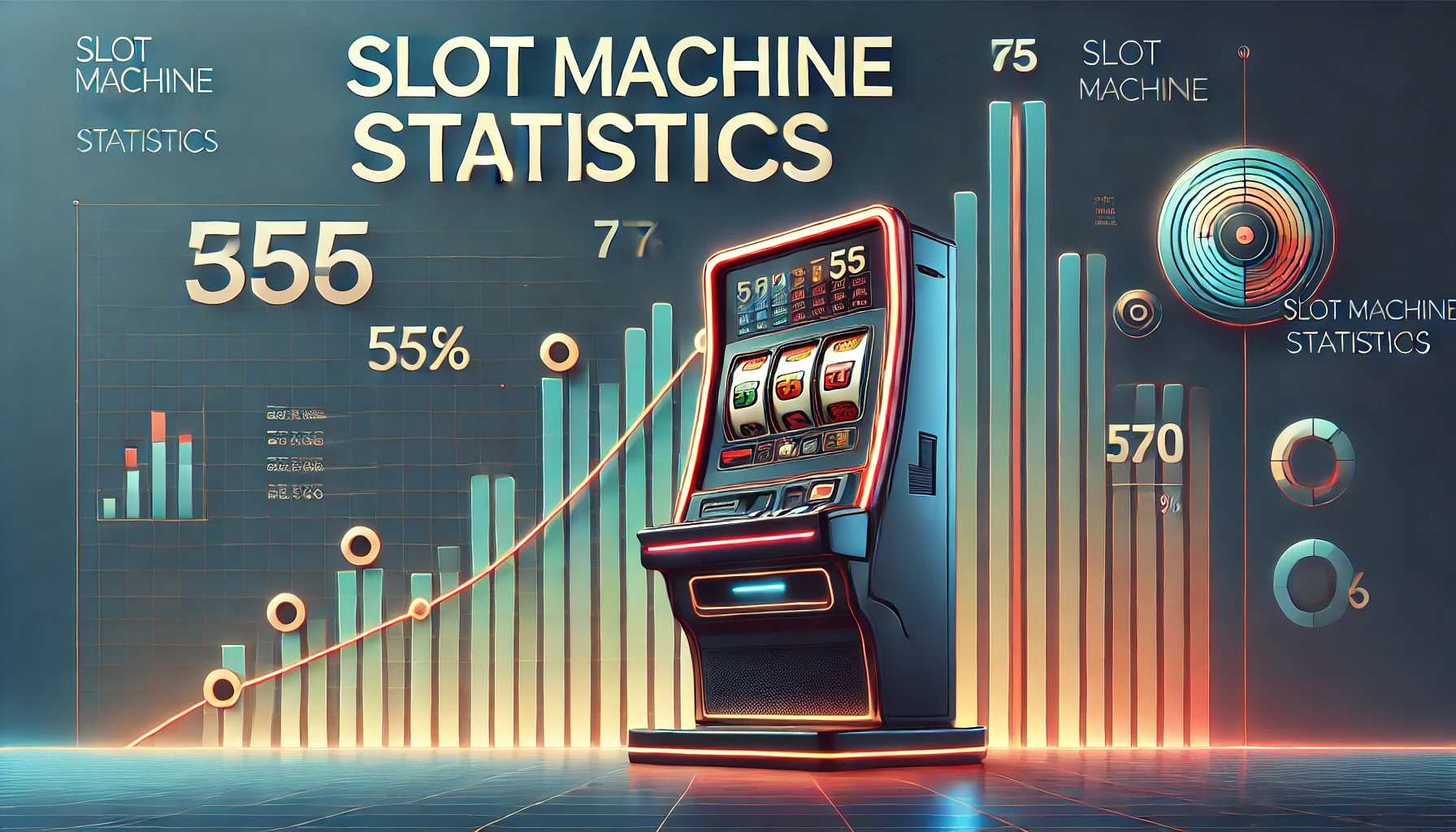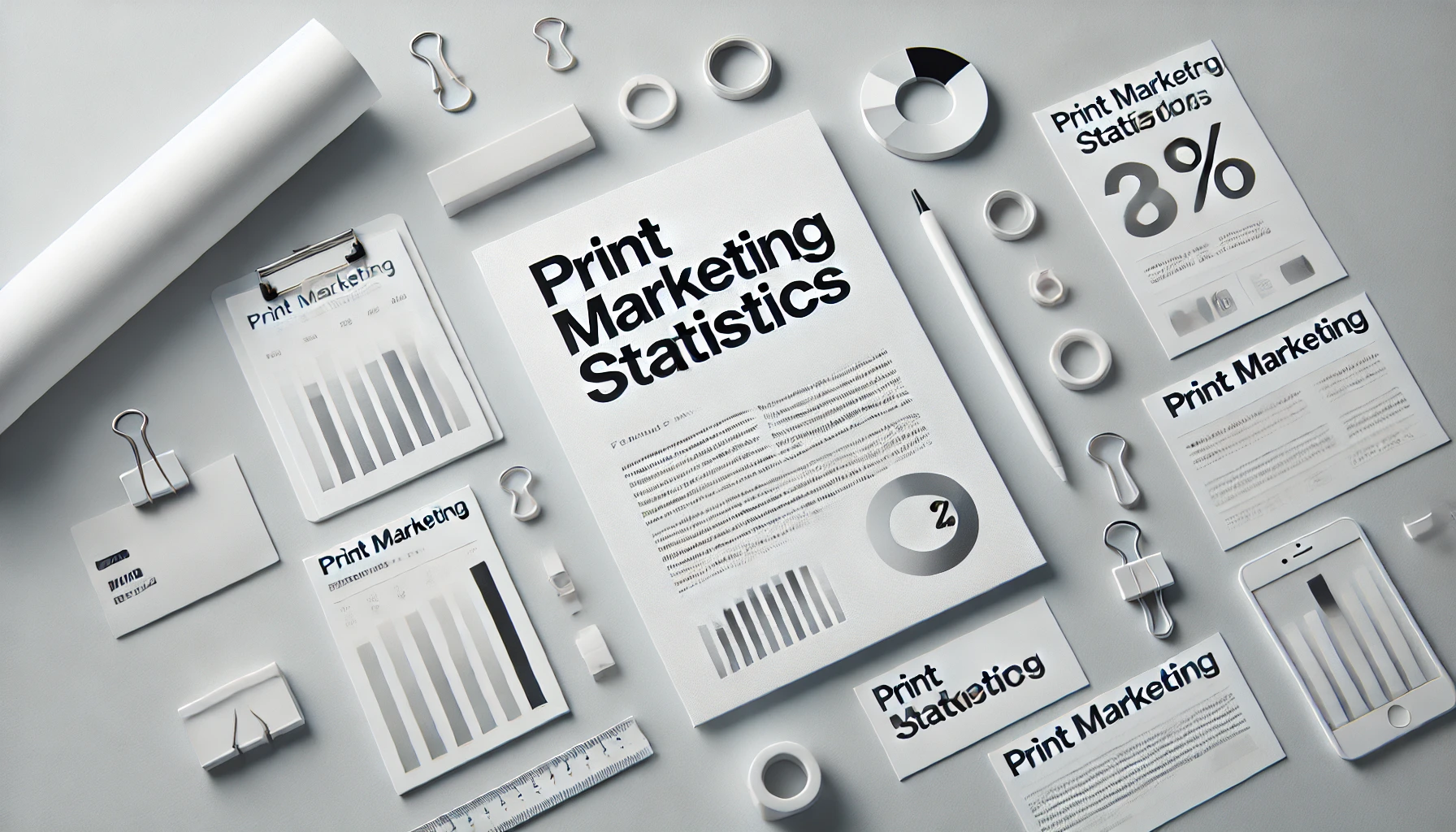Supply Chain Statistics By Growth, Transport Costs, Region, Market Size And Facts
Updated · Aug 21, 2024
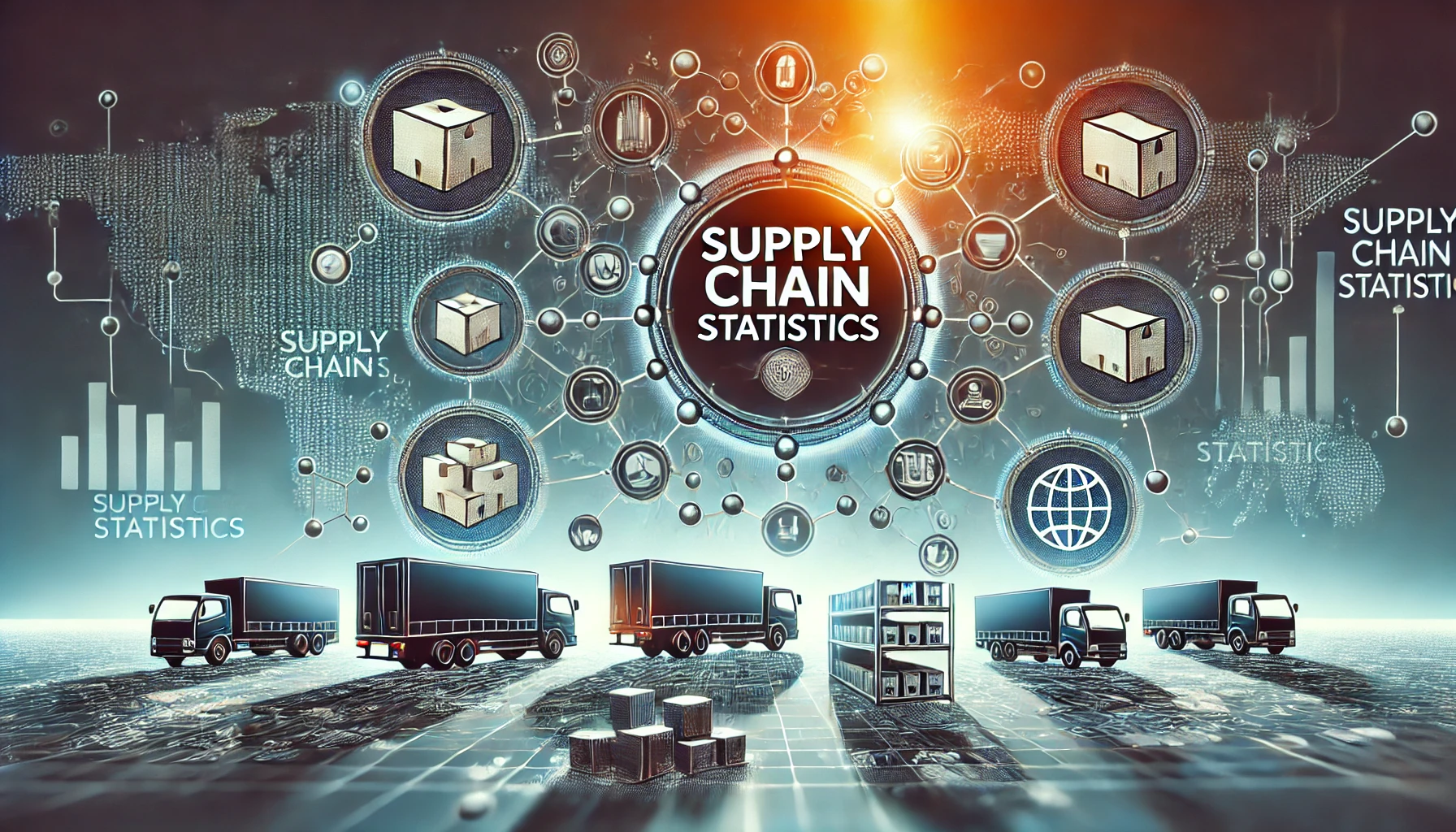
WHAT WE HAVE ON THIS PAGE
- Introduction
- Editor’s Choice
- What is A Supply Chain?
- Supply Chain Management And Models
- Worldwide Supply Chain Market Estimation
- Shipping and Transportation Statistics
- Supply Chain Investment Priorities Statistics
- Supply Chain Industry Technology Adoption Statistics
- Supply Chain Market Insights Statistics
- Essential Facts About Supply Chain
- Artificial Intelligence In Supply Chain Statistics
- Cost Of Supply Chain Disruption Statistics
- Challenges Of Big Supply Chain In 2023
- Conclusion
Introduction
Supply Chain Statistics: A supply chain is a network of people and companies that work together to create and deliver a product to the customer. It begins with those who provide raw materials and ends when the finished product reaches the consumer. Managing the supply chain is very important because a well-run supply chain can reduce costs and make production more efficient. Companies aim to improve their supply chains to lower expenses and stay competitive in the market.
By keeping track of inventory levels, analyzing shipping costs, and spotting any delays, businesses can use these statistics to make their supply chain operations better. In this article, “Supply Chain Statistics”, we shall explore the main metrics used in SCM and show how businesses can use this data to stay ahead of the competition.
Editor’s Choice
- By 2026, 55% of the top 2,000 global manufacturers will redesign their service supply chains with AI.
- By 2024, half of all companies will start using more balanced multi-shoring strategies to manage risks better.
- The market for supply chain risk management software is expected to grow to $1.3 billion by 2025.
- Supply Chain Statistics stated that the supply chain finance market is forecasted to reach $72.6 billion by 2024.
- By 2025, more companies are expected to adopt digital tools for tracking, managing contracts, and handling supply chain finances.
- E-commerce sales have jumped 44% worldwide, increasing the need for flexible supply chains.
- The market for supply chain collaboration software should surpass $2 billion by 2026.
- The use of robots in supply chains is forecasted to grow by 14% each year until 2025.
- By 2025, 70% of organizations will use digital adoption platforms across all their technology to improve user experiences.
- The supply chain analytics market is expected to grow to $10.7 billion by 2027.
- The market for supply chain visibility solutions is projected to reach $21.8 billion by 2026.
- 63% of companies have faced supply chain disruptions due to climate change.
- The market for supply chain orchestration software is expected to hit $6.8 billion by 2028.
- The market for digital transformation in supply chains is projected to grow to $296.2 billion by 2027.
- The market for supply chain optimization software is expected to surpass $9.2 billion by 2026, as per Supply Chain Statistics.
- The digital supply chain market is expected to reach $21.3 billion by 2026.
- The market for supply chain risk management solutions should grow to $17.7 billion by 2027.
- The supply chain data analytics market is projected to hit $12.5 billion by 2026.
- 56% of companies have experienced supply chain disruptions due to geopolitical issues.
- The market for supply chain cloud solutions is expected to surpass $12.4 billion by 2026, as per Supply Chain Statistics.
- The industry for supply chain visibility level is estimated to increase $8.2 billion by 2026.
What is A Supply Chain?
A supply chain is a detailed system that includes different facilities working together to turn raw materials into finished products and then deliver these products to customers. Supply chain management focuses on making sure that this process happens as efficiently as possible.
In advanced supply chains, used products can re-enter the system if they still have value that can be recycled. Supply chains connect different value chains. Suppliers in a supply chain are often categorized by “tier”: first-tier suppliers provide products directly to the client, second-tier suppliers provide to the first-tier suppliers, and so on.
Supply Chain Management And Models
Supply chain management (SCM) involves overseeing how materials, information, and money move from suppliers to manufacturers, then to wholesalers, retailers, and finally to customers. There are three main types of flows in the supply chain: the flow of products, the flow of information, and the flow of finances. These flows occur in three main stages: strategy, planning, and operation. SCM is about coordinating and connecting these flows within and between companies.
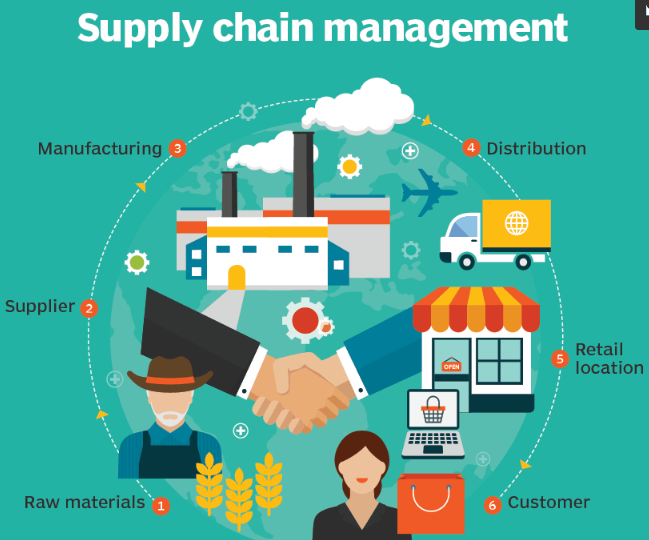
(Source: techtarget.com)
Supply chains can follow different business models, each focusing on either being responsive or efficient. While each model aims to balance both goals, they each approach this in different ways and usually prioritize one over the other. Companies can assess which model aligns best with their goals and limitations.
Here are the main supply chain models:
- Continuous Flow Model: This model is best for stable industries where demand is steady.
- Agile Model: Ideal for industries with unpredictable demand and products made to order.
- Fast Chain Model: Suited for products with a short lifecycle, like fashion items.
- Flexible Model: Works well in stable industries with occasional predictable demand spikes.
- Custom Configured Model: Focuses on customizing products.
- Efficient Chain Model: Best for highly competitive markets where pricing is crucial.
Worldwide Supply Chain Market Estimation
- By 2027, the market for supply chain cloud solutions is predicted to reach $40 billion.
- The market for supply chain management software is expected to hit $26.72 billion by 2025.
- 41% of supply chain leaders think environmental sustainability will be a major factor in future supply chain strategies.
- 67% of organizations have faced supply chain problems due to trade regulations and tariffs.
- The cold chain market is anticipated to reach $255.84 billion by 2025.
- 59% of organizations have experienced supply chain disruptions because of climate change.
- The market for supply chain analytics is projected to hit $9.88 billion by 2027.
- By 2024, the market for blockchain in supply chains should reach $1.8 billion.
- Supply Chain Statistics stated that the digital supply chain market is estimated to grow to $8.84 billion by 2026.
- Worldwide spending on supply chain management software is expected to exceed $19 billion by 2022.
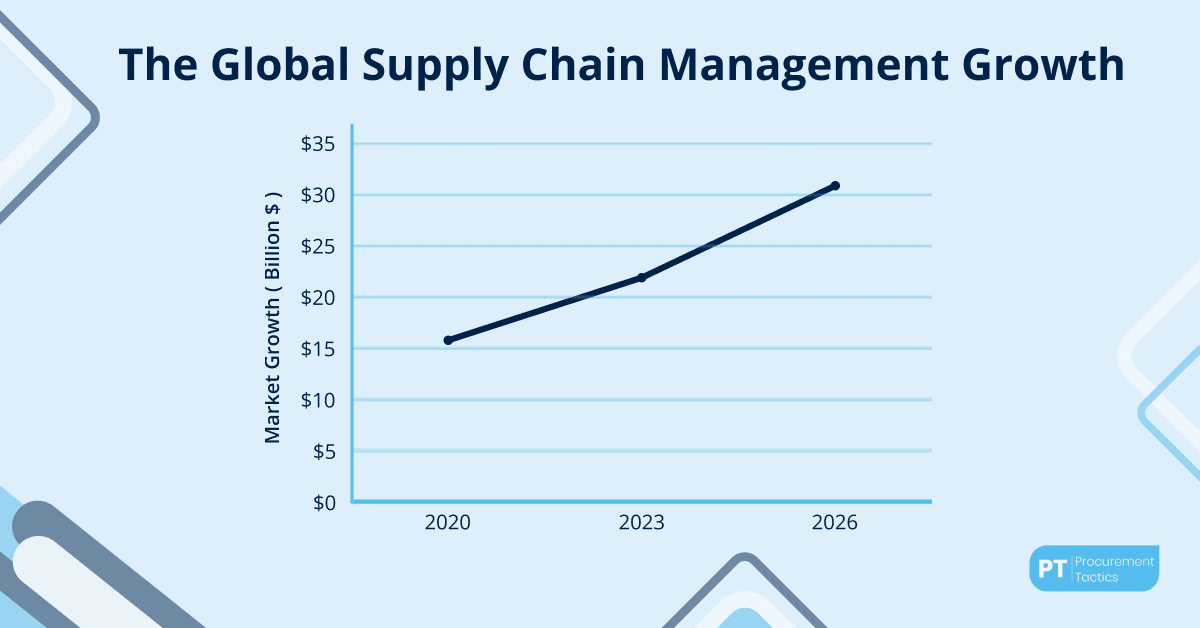
(Source: procurementtactics.com)
- The global market for supply chain risk management is forecasted to grow to $3.2 billion by 2025.
- 76% of companies plan to increase their supply chain transparency over the next three years.
- The food supply chain market should grow to $178.9 billion by 2025.
- The aerospace and defense supply chain market is expected to reach $133.78 billion by 2025.
- The e-commerce supply chain market is projected to hit $13.42 billion by 2028.
- The pharmaceutical supply chain market is forecasted to grow to $186.65 billion by 2025.
- The supply chain risk index reached a record high of 5.53 in 2021, as per Supply Chain Statistics.
- 81% of manufacturers say demand volatility has increased over the past five years.
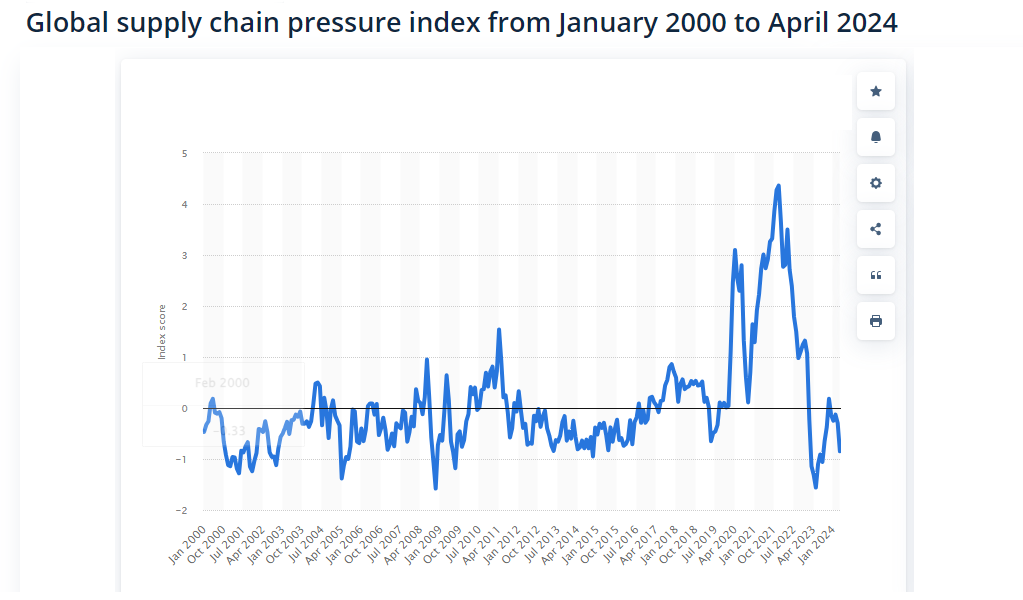
(Source: statista.com)
- In April 2024, the global supply chain pressure index dropped to -0.85 points, down from -0.3 points the month before.
- This decrease shows that after the tough conditions caused by the COVID-19 pandemic, supply chain pressure has now returned to levels seen before the pandemic.
- The supply chain visibility software market is expected to reach $8.35 billion by 2027.
- The supply chain analytics market is projected to grow to $10.7 billion by 2027.
- Supply Chain Statistics stated that the automotive supply chain market is expected to reach $181.5 billion by 2025.
- The market for supply chain network design software is estimated to reach $180.76 million by 2027.
- The market for supply chain automation is predicted to exceed $13 billion by 2024.
- The global logistics market size is projected to reach $6.5 trillion by 2023.
Shipping and Transportation Statistics
Shipping and transportation are very competitive fields. To stay ahead, businesses should use the right software to make deliveries easier and analyze data to improve their shipping strategies.
- By the end of 2025, transportation management systems (TMS) are expected to make up $4.8 billion of the global market.
- In 2023, supply chain businesses expected a 34% monthly increase in ships at the port of Shanghai.
- Supply Chain Statistics stated that around 77% of ports worldwide are experiencing unusually long turnaround times.
- By 2028, the TMS market is expected to grow at a rate of 11.7% per year.
- From 2022 to 2030, the global TMS market is projected to grow at a rate of 14.6% per year, with the market value expected to be $9.22 billion in 2021.
- 50% of vehicles return to warehouses empty. Both e-commerce and retail are facing disruptions at the same time.
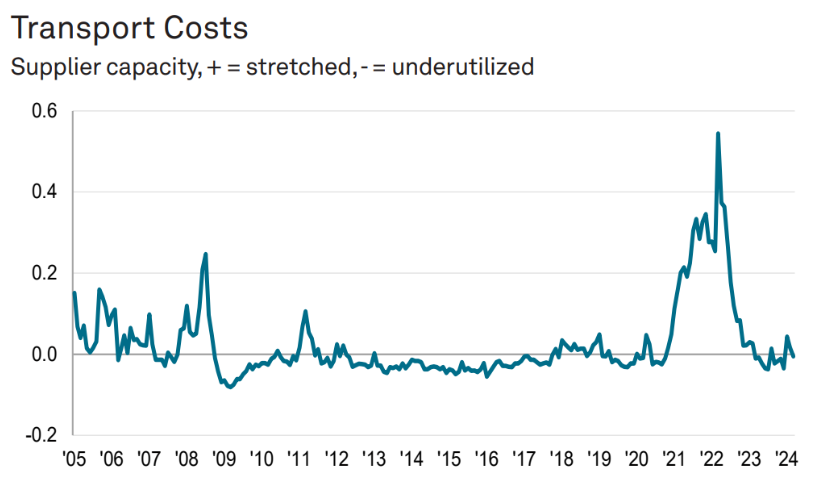
(Source: Gep.com)
- Right now, transportation and logistics account for 12% of the world’s GDP.
- 74% of supply chain organizations use four or more types of transportation.
- Using a TMS can reduce freight invoice payments by 90–95%.
- Transportation management systems can cut freight costs by 8%.
- Only 35% of shipping companies use TMS for their supply chain management.
- 53% of executives plan to use dual sourcing for raw materials.
- Executives aim to increase their critical product inventories by 47%.
- 35% of businesses use TMS solutions to manage their transport networks.
- During COVID-19, the TMS market quickly grew at a rate of 3-4% per year.
- The logistics sector is expected to lose $7 billion in revenue by 2025.
- 51% of businesses are likely to use cloud-based TMS.
- 15% of companies plan to add more distribution centers.
- 30% of companies will reduce the number of stock-keeping units (SKUs) they offer.
- In 2020, 38.8% of small businesses in the US witnessed supply chain delays because of the COVID-19 pandemic.
- 90% of global goods are transported by ships and containers, as stated by Supply Chain Statistics.
- Only 6% of businesses report having full supply chain visibility.
Supply Chain Investment Priorities Statistics
- The global supply chain industry is expected to reach $37.41 billion by 2027.
- 30% of supply chain leaders say sustainability is a top priority for their organization.
- The global cold chain logistics market is estimated to grow at a rate of 15% per year from 2021 to 2026.
- 91% of supply chain leaders plan to invest more in cybersecurity to protect their supply chain networks.
- Nearly 70% of consumers are willing to pay more for products from companies with sustainable supply chains.
- 79% of companies with top-performing supply chains see revenue growth much higher than average.
- 44% of supply chain leaders focus on investing in supply chain visibility to reduce risks.
- About 55% of supply chain professionals say the biggest challenge is the need for more visibility.
- Supply Chain Statistics stated that almost 62% of organizations prioritize sustainability in their supply chain operations.
- 90% of supply chain executives believe sustainable supply chain management is important for their companies.
- Emerging markets make up 40% of the global supply chain market growth.
- Suppliers are responsible for an average of 80% of a company’s environmental impact.
- 45% of supply chain professionals think that demand forecasting is the most crucial process to digitize.
- The global supply chain finance market is expected to grow to $799.24 billion by 2025.
- 52% of consumers say they would switch brands for a more sustainable option, even if it costs more.
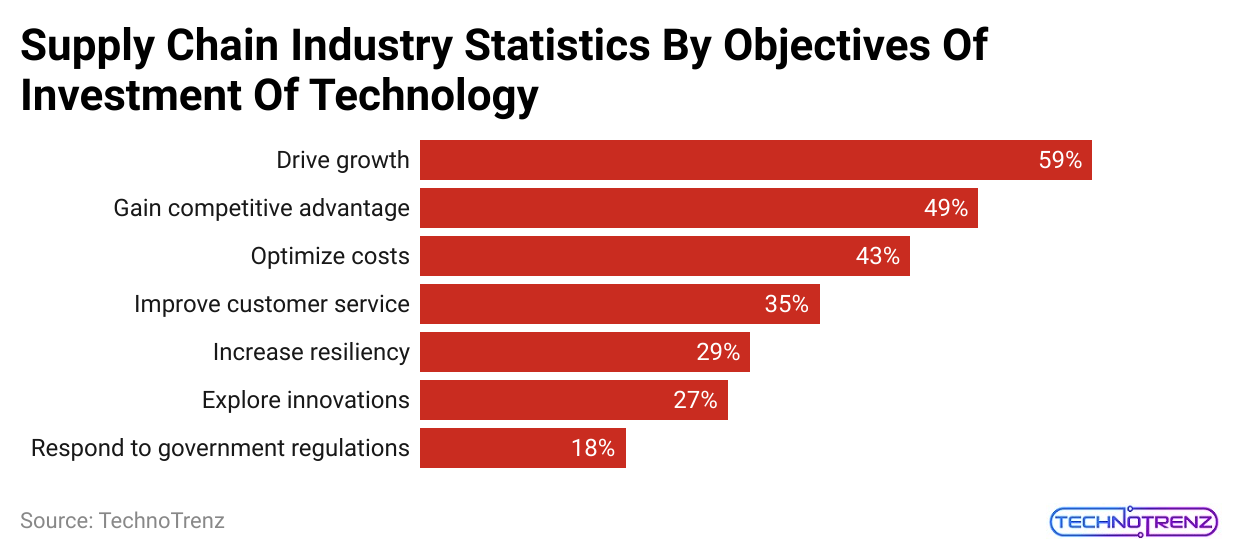
(Reference: coolest-gadgets.com)
| Respond to government regulations | 18% |
| Explore innovations |
27% |
|
Increase resiliency |
29% |
| Improve customer service |
35% |
|
Optimize costs |
43% |
| Gain competitive advantage |
49% |
|
Drive growth |
59% |
- 68% of supply chain leaders think sustainability efforts positively impact profitability.
- In 2022, 45% of supply chain leaders plan to invest heavily in digital supply chain transformation.
- 76% of businesses agree that digitalization helps improve supply chain resilience.
- The global e-commerce logistics market is projected to grow at a rate of 20% per year from 2021 to 2026.
- Most supply chain professionals see visibility into transportation as a major challenge in logistics management.
- 47% of supply chain professionals believe climate change will significantly impact supply chain operations in the next decade.
- About 70% of supply chain leaders are making sustainability a key strategic goal.
- 43% of supply chain professionals believe real-time inventory visibility is the most important supply chain capability.
- 57% of companies see end-to-end supply chain visibility as the main reason for investing in supply chain technology.
- 80% of supply chain professionals plan to increase investments in supply chain analytics over the next two years.
- Supply Chain Statistics stated that the global cold chain logistics market is expected to reach $447.50 billion by 2025.
- About 60% of supply chain professionals prioritize investing in cybersecurity to prevent data breaches.
- 45% of supply chain executives believe climate change is a significant risk to global supply chains.
Supply Chain Industry Technology Adoption Statistics
- By 2023, 50% of leading global companies will have invested in real-time transportation visibility platforms.
- 61% of organizations see digitizing the supply chain as essential for long-term success.
- The global supply chain management market is expected to be worth $37.41 billion by 2027.
- 70% of companies plan to invest in technologies for better supply chain visibility over the next two years.
- Automation is predicted to cut supply chain labor costs by 10% to 20% by 2030.
(Reference: pwc.com)
- The global supply chain analytics market is expected to reach $10.9 billion by 2025.
- The global trade management software market is projected to grow to $1.35 billion by 2025.
- Supply Chain Statistics stated that almost 45% of companies have invested in blockchain technology to enhance supply chain security.
- The global warehouse management system market is expected to reach $5.9 billion by 2027.
- The adoption of IoT in supply chain management is forecasted to cut operating costs by 30% by 2025.
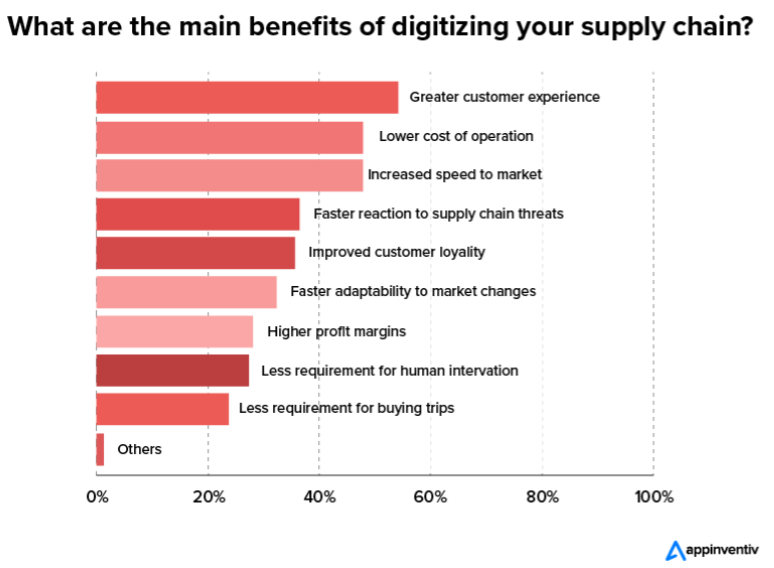
(Source: appinventiv.com)
- 56% of logistics companies plan to invest in predictive analytics to optimize their supply chains in the next two years.
- The global transportation management system market size is expected to hit $21.5 billion by 2025.
- The blockchain in the logistics market is projected to grow at a rate of 48% per year from 2021 to 2026.
- The global supply chain optimization software market is expected to exceed $7 billion by 2028.
- Blockchain technology can lower supply chain transaction costs by 35%.
- Using AI in supply chain and logistics is expected to improve operational efficiency by 5-10%.
- 88% of supply chain executives believe that digital supply chains will become the main model in the next five years.
- Robotics in warehouses could boost productivity by up to 30%, as stated by Supply Chain Statistics.
- 71% of supply chain professionals think AI and machine learning are key to driving innovation.
- The global inventory management software market is estimated to reach $3.2 billion by 2026.
- 66% of supply chain leaders believe predictive analytics will be crucial for accurate demand forecasting.
- The global supply chain visibility software market is anticipated to grow to $17.23 billion by 2026.
- 39% of organizations aim to cut supply chain operational costs through technology investments in the next two years.
Supply Chain Market Insights Statistics
- The global supply chain management market was valued at $28.60 billion in 2023. It is projected to grow to about $81.93 billion by 2033, with a steady annual growth rate of 11.1% from 2024 to 2033.
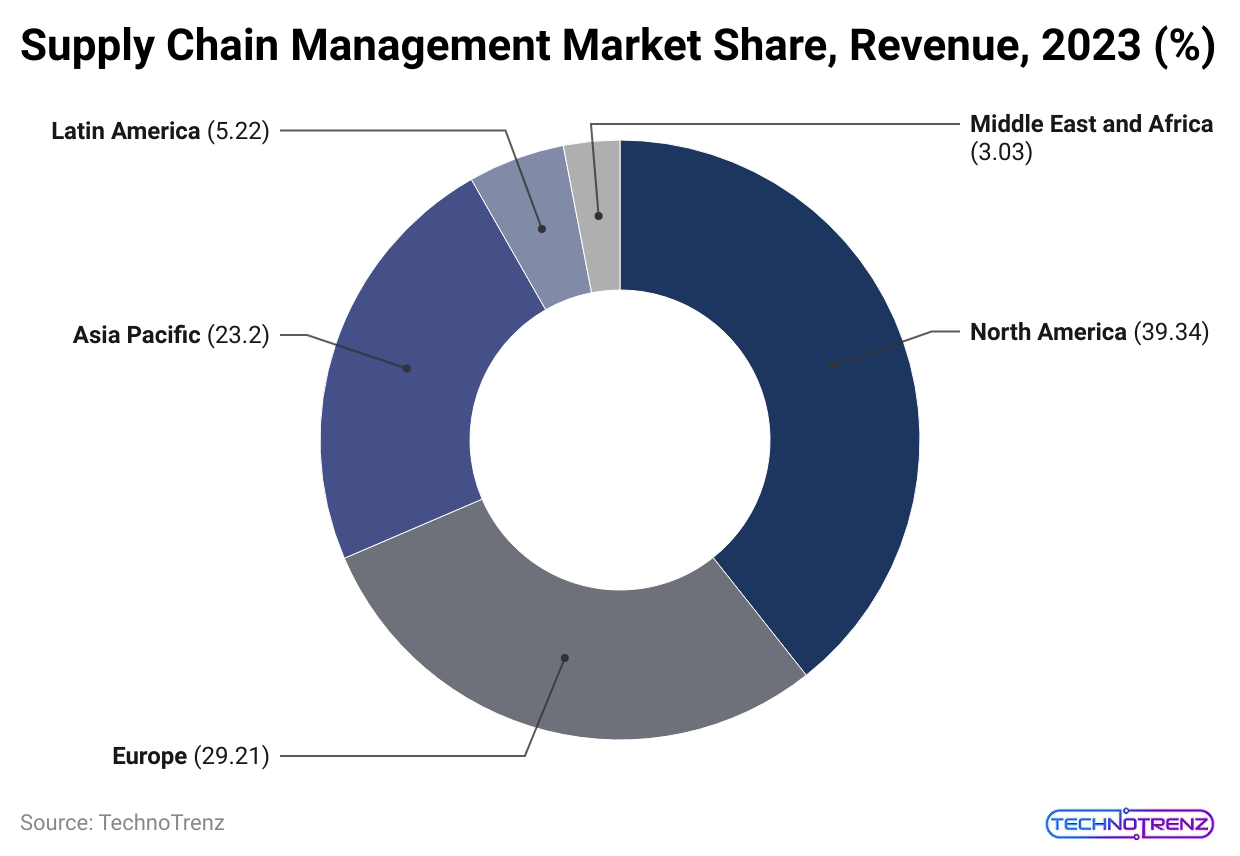
(Reference: precedenceresearch.com)
| Region | % |
| North America |
39.34% |
|
Europe |
29.14% |
| Asia Pacific |
23.20% |
|
Latin America |
5.22% |
| Middle East and Africa |
3.03% |
- In 2023, North America held the largest market share at 39.34%.
- In terms of components, the solution segment had the largest market share in 2023.
- For enterprise size, large enterprises had the biggest share in 2023.
- Regarding deployment mode, on-premises solutions led the market in 2023.
(Reference: precedenceresearch.com)
- In the US, the supply chain management market was estimated at $7.89 billion in 2023.
- It is expected to reach about $23.84 billion by 2033, growing at an annual rate of 11.7% from 2024 to 2033.
| Year | In Billion USD |
| 2023 |
$7.89 |
|
2024 |
$8.81 |
| 2025 |
$9.84 |
|
2026 |
$11 |
| 2027 |
$12.28 |
|
2028 |
$13.72 |
| 2029 |
$15.32 |
|
2030 |
$17.11 |
| 2031 |
$19.11 |
|
2032 |
$21.35 |
| 2033 |
$23.84 |
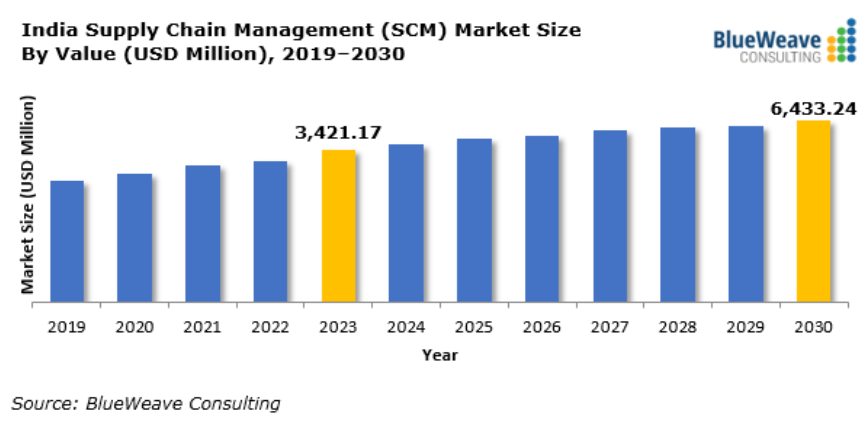
(Source: blueweaveconsulting.com)
- The supply chain management (SCM) market in India was valued at $3.42 billion in 2023.
- It is expected to grow at a rate of 11.1% each year from 2024 to 2030, reaching around $6.43 billion by 2030.
- India, known as one of the fastest-growing economies, saw a real GDP growth of 7.2% from 2022 to 2023.
Essential Facts About Supply Chain
- The Bureau of Labor Statistics (BLS) reports that more than five million people are employed in transportation and warehousing jobs in the US.
- Supply Chain Statistics report shows that the use of supply chain management software grew by 9% last year. By 2025, this market is expected to exceed $22 billion.
- As the internet expands, the number of online shoppers worldwide is increasing. It is estimated that e-commerce will account for 22% of global retail sales by 2023, up from 14.1% in 2019.
- Third-party logistics providers often handle large portions of the shipping process, positively impacting customer service. According to 83% of shippers, 3PLs have improved their customer service.
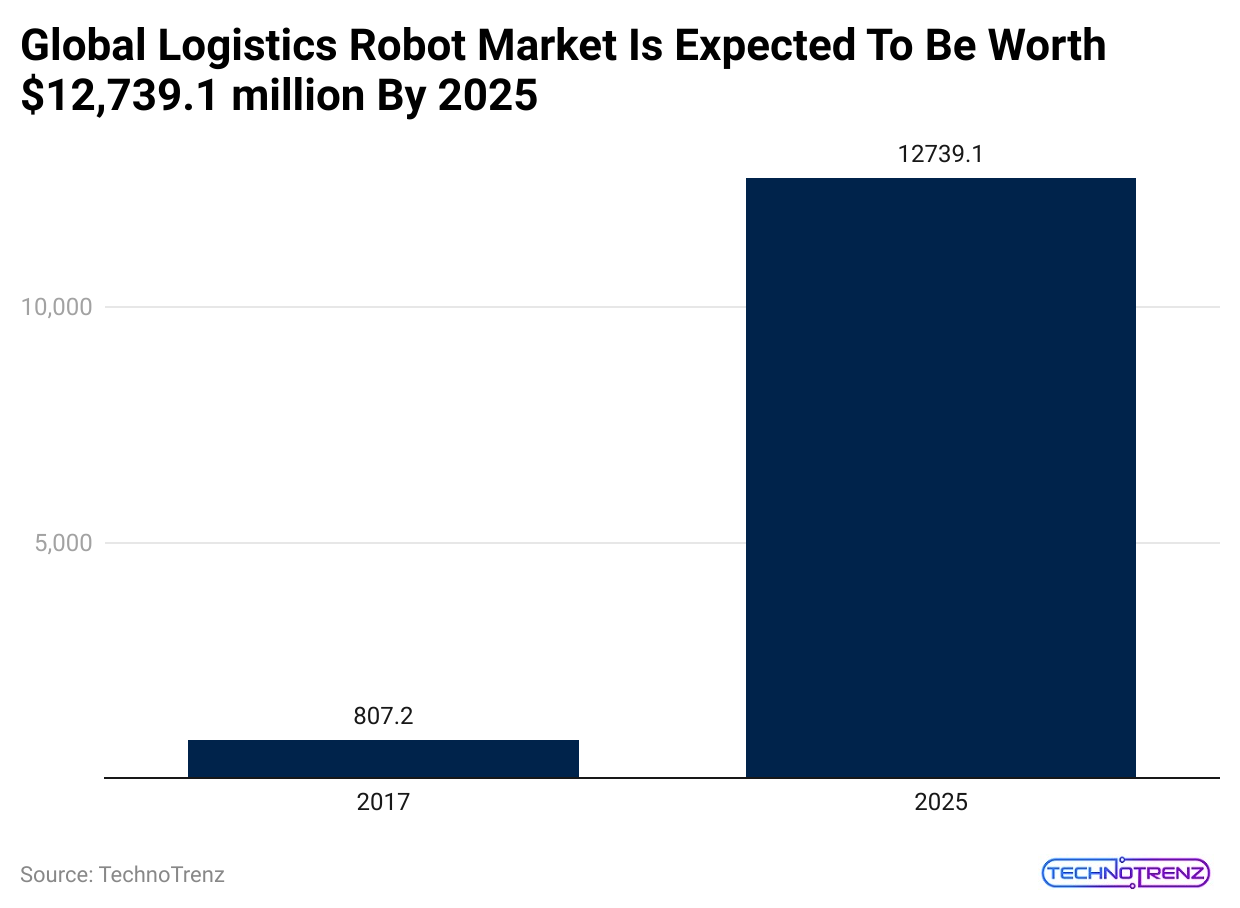
(Reference: procurementtactics.com)
- In the above chart, we can see the Global Logistic Robot Market statistics that is estimated to be worth $12,739.1 million by 2025.
- Same-day shipping is becoming more common, with 65% of retailers expected to offer it by the end of the year. This growing expectation is driving more demand for efficient supply chains.
- Radiofrequency identification (RFID) is enhancing supply chains by increasing inventory accuracy to 95%. RFID tags help warehouse workers track goods more efficiently and speed up shipping.
- Trucks continue to be the leading method of shipping, making up 63.3% of freight transportation in North America.
- Air shipping is now a $44 billion industry, accounting for 3.8% of the US freight market. It’s more expensive than trucking but growing, especially in U.S.-Canada shipping.
- Last-mile delivery, the final stretch before reaching the customer, is challenging due to traffic and route complexity. Drones, though not yet widely used, could potentially improve this part of the process.
- The worldwide supply chain industry was valued at $15.85 billion and is predicted to grow to nearly $31 billion by 2026.
- By 2027, it is projected to reach $42.46 billion, growing at an annual rate of 10.4%.
- Lowering supply chain values between 9% to 4% can significantly boost profits. For market suppliers, optimizing costs from 13.2% to 7.9% can save 40%.
- 57% of organizations think that efficient supply chain management results in an advantage. Additionally, 70% see it as crucial for high-quality customer service.
- Supply Chain Statistics stated that the companies benefit from a wider range of products, customization, reliability, sustainability, and fast delivery.
- Demand for these factors is increasing, and customization and fast delivery are seeing the highest growth.
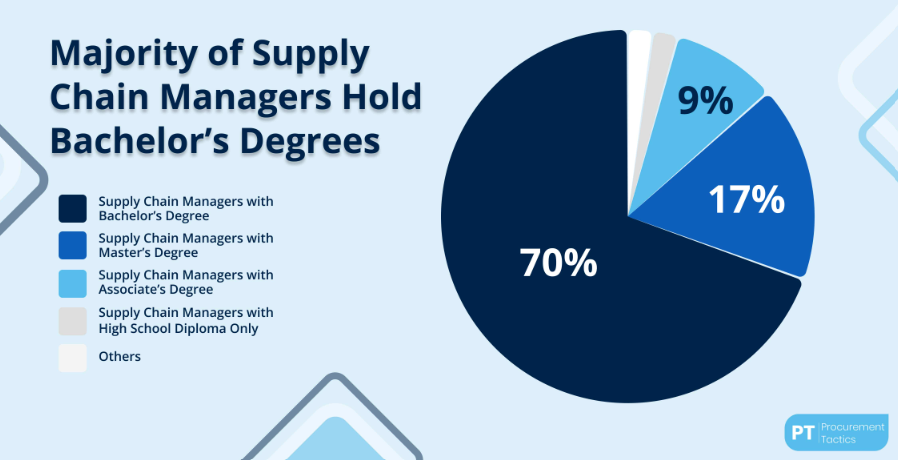
(Source: procurementtactics.com)
- In the pie chart above, we can see the statistics on the education levels of US supply chain managers.
- The worldwide supply chain industry is predicted to grow at a rate of 11.2% per year, increasing between $15.85 billion in 2020 to $37.41 billion by 2027.
- About 67.4% of supply chain officials use Excel spreadsheets for management. This figure increases with experience, with nearly 75% of experienced managers using them.
- During COVID-19, out-of-stock goods were valued at $1.14 trillion, twice the value of loaded extra stocked items.
- 12% of global retailers reported severe supply chain disruptions because of the pandemic COVID-19, while 32% experienced minimal disruptions. Maintaining stock was a major challenge for 28% of retailers.
- Disruptions in the supply chain can result from a 62% loss in finances and significantly impact reputation and logistics, with average losses of 54%.
- The Key supply chain issues include high transport costs, proper inventory count, and on-time delivery and pickup, as per Supply Chain Statistics.
- Accurate inventory tracking is a challenge for many small businesses, and delays in pickup and delivery can disrupt the entire supply chain.
- The supply chain and logistics sectors offer many job opportunities. The pandemic has highlighted the importance of this industry, increasing interest and demand for careers in this field.
- The future of supply chains involves digitalizing processes, internationalizing exchanges, and developing a strategic vision.
- Companies need to automate tasks, use data analytics, and explore global markets to stay competitive and optimize their supply chains.
Artificial Intelligence In Supply Chain Statistics
- By 2023, more than half of the world’s top companies will invest in AI and advanced analytics for their supply chains.
- The use of AI in supply chain and logistics is expected to grow by 45% from 2019 to 2025.
- AI-powered supply chain analytics can make decision-making 50% better.
- Using AI in supply chain operations can cut procurement costs by 25-30%.
- Supply Chain Statistics stated that AI can improve warehouse efficiency, increasing order processing speed by 25%.
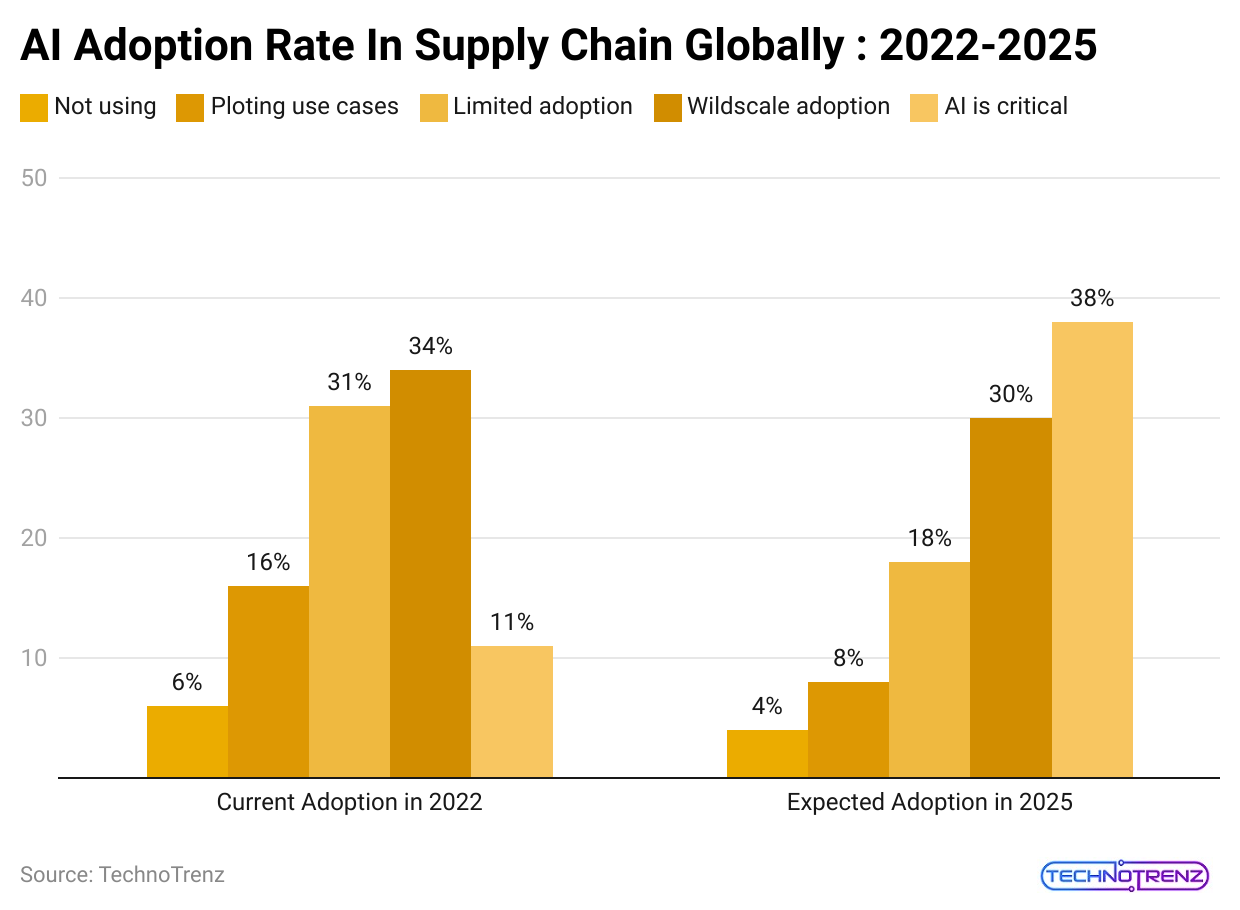
(Reference: appinventiv.com)
- AI can lower supply chain disruptions by up to 40% with predictive risk analysis.
- Implementing AI can enhance forecasting accuracy by 20-25%.
- AI in supply chain logistics can shorten order processing times by 30-40%.
- AI-driven demand sensing can cut forecasting errors by 30-35%.
- AI management in the supply chain can reduce costs by 10-20%.72% of organizations think AI will be a key competitive edge in supply chain management by 2025.
- AI-enhanced demand forecasting can cut forecasting mistakes by up to 50%, according to supply chain statistics.
- AI in supply chain management can lead to a return on investment (ROI) increase of up to 300%.
- 65% of supply chain leaders believe AI will greatly affect supply chain strategies in the next five years.
- AI can lower supply chain costs by 30% while boosting delivery performance by 87%.
- 94% of supply chain experts believe AI and machine learning will transform supply chain management.
- AI can increase supply chain productivity by up to 30%.
- Over 70% of supply chain firms plan to invest more in AI and machine learning over the next five years.
- AI adoption in logistics and supply chains is expected to grow by 42% from 2020 to 2025.
- 84% of companies using AI in supply chain management have seen a revenue increase.
- 90% of supply chain data is unstructured, making AI crucial for processing and analyzing it.
- AI automation can cut manual order processing costs by 30%.
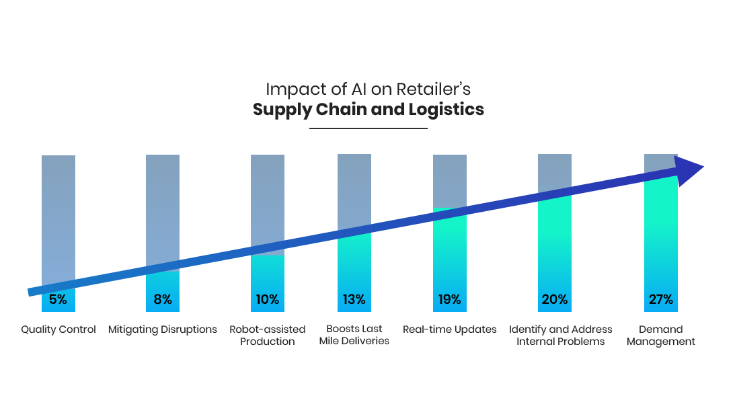
(Source: erpsolutions.oodles.io)
- AI can help make supply chains more sustainable by reducing carbon emissions by 15-20%.
- Companies using AI for predictive analytics in supply chain management have seen a 30-35% drop in transportation costs.
- AI route optimization can lower transportation costs by 10-15%.
- AI-powered chatbots can manage up to 70% of customer questions in supply chain management.
- AI in supply chain forecasting can improve accuracy by 20-25%.
- Companies using AI in supply chain management have reported a 40-50% reduction in stock-outs.
- Companies using AI for demand sensing have seen a 20-25% improvement in forecast accuracy.
- AI route optimization can lead to a 25-30% decrease in delivery lead times.
- AI enhances supply chain risk management, reducing disruptions by 20-25%.
- Adopting AI in supply chain management can improve customer satisfaction by 30-35%.
- AI can optimize supply chain network design, saving costs by 20-30%.
- AI can make supply chains more responsive, cutting lead times by 15-20%.
- Companies using AI for supply chain planning have reduced excess inventory by 30-40%.
- AI technologies in supply chain management can increase inventory turnover by 20-30%.
- AI analytics can cut procurement cycle times by 20-30%, as per Supply Chain Statistics.
- AI can lower supply chain operation costs by 15-20% through automation.
- Using AI in supply chain management can boost warehouse efficiency by 25-30%.
- AI predictive maintenance can reduce maintenance costs in supply chains by 20-25%.
- AI can cut transportation costs in the supply chain by 10-15%.
- AI increases supply chain flexibility, reducing time to market by 30-35%.
- AI-driven supply chain optimization can lower inventory carrying costs by 15-20%.
- AI can enhance supply chain visibility, reducing inventory by up to 25%.
Cost Of Supply Chain Disruption Statistics
Direct Revenue Loss
- According to Interos’s Annual Global Supply Chain Report from spring 2021, organizations lose an average of $184 million each year due to supply chain disruptions.
- 94% of the companies surveyed reported a negative impact on their revenue because of these disruptions.
- Supply Chain Statistics estimates that, over the next ten years, disruptions could cost companies almost half (45%) of a year’s profits.
- A major production disruption could result in a loss of 30-50% of a year’s EBITDA, while a shorter disruption (30 days or less) might lead to losses of 3-5% of EBITDA.
- The Economist found that two-thirds of businesses surveyed lost 6-20% of their revenue due to disruptions from the pandemic.
Productivity Loss
- 85% of global supply chains saw reduced operations, and 6% had to shut down completely.
- Supply shortages led to delays and halted revenue-generating activities.
- The National Retail Federation reports that 97% of its members faced delays at ports and in shipping, with 70% experiencing 2 to 3 weeks of delays because of congestion. This resulted in higher costs for transportation and warehousing.
- In the US, 71% of goods require trucking, and there is a significant driver shortage.
- The American Trucking Association estimates the industry needs to hire 1.1 million drivers over the next decade to replace retiring truckers and meet demand.
Reputational Damage
- Most respondents (83%) reported reputational harm due to supply chain disruptions.
- This impact is hard to measure but includes losing customers and struggling to attract new business.
Challenges Of Big Supply Chain In 2023
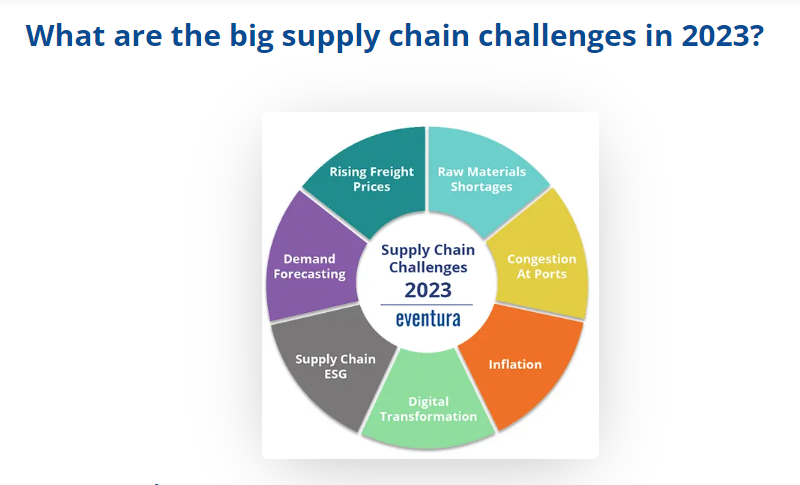
(Source: eventura.com)
- Rising Freight Prices – Since the pandemic began, the need for shipping containers has gone up. Increased e-commerce sales mean more imports of both consumer goods and raw materials. This high demand has led to shipping inefficiencies and a shortage of available containers.
- Raw Material Shortages – In 2023, many retailers and suppliers are still struggling to keep up. Global issues, like the war in Ukraine, have made the situation worse. Companies might need extra working capital to manage these shortages and prepare for busy periods.
- Congestion and Delays at Ports – Port congestion continues to be a major issue. Problems like labor shortages and COVID-19 restrictions have disrupted port operations. Businesses that rely on imports need to plan and adjust their expectations to avoid disappointment.
- Supply Chain ESG (Environmental, Social, and Governance) – ESG concerns, including sustainability and ethical practices, are becoming more important. Companies need to meet compliance standards and improve their environmental and social impact.
- Digital Transformation – Adopting digital technologies can greatly benefit supply chains, but it needs to be done right. Tools like artificial intelligence, drones, electric vehicles, and ERP systems can be very helpful. Keeping up with digital advancements is crucial to stay competitive. Effective digital systems can improve supply chain management and overall efficiency.
- Inflation – Rising inflation and the cost of living are increasing expenses in procurement, manufacturing, and delivery. These higher costs can reduce profits and might lead to higher prices for consumers. Good inventory management can help cut costs, and negotiating better prices with suppliers can boost profitability. Reviewing your pricing strategy and finding ways to improve cash flow, like switching payment plans, can also help manage the financial strain.
Conclusion
The supply chain industry is always improving to meet the rising demands for speed and accuracy. It’s using advanced tools like predictive analytics and machine learning to make better decisions. Companies are also adopting digital transformation strategies, such as blockchain technology, to enhance data analysis, tracking, and the management of goods. Augmented Reality (AR) helps with efficient data collection and transmission.
These new technologies offer several benefits, including cost savings through better analysis, improved customer service, optimized inventory management, and better planning. However, there are still challenges related to compliance and changes in the global economy. We have shed more light on Supply Chain Statistics through this article.
Sources
FAQ.
Between 2022 and 2023, the number of software packages hit by supply chain cyberattacks dropped sharply, from about 186,000 to over 24,000. From January to March 2023, 17,150 software packages were affected by these cyberattacks.
The main problems in the supply chain often arise from increasingly global and complex operations. These problems include shipping delays and needing more flexibility to adjust to changing markets and customer demands.

Saisuman is a professional content writer specializing in health, law, and space-related articles. Her experience includes designing featured articles for websites and newsletters, as well as conducting detailed research for medical professionals and researchers. Passionate about languages since childhood, Saisuman can read, write, and speak in five different languages. Her love for languages and reading inspired her to pursue a career in writing. Saisuman holds a Master's in Business Administration with a focus on Human Resources and has worked in a Human Resources firm for a year. She was previously associated with a French international company. In addition to writing, Saisuman enjoys traveling and singing classical songs in her leisure time.


